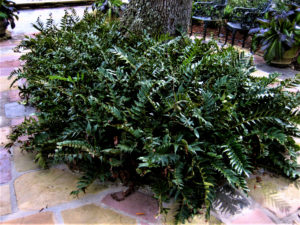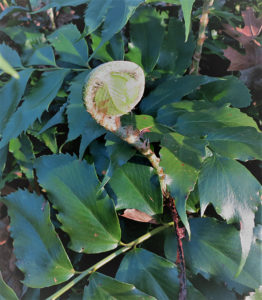- Fragile Planet Offers a Nighttime Wildlife Experience
- Falcons Soccer Off & Running
- Cameron County Receives Funds to Improve Two Parks
- Falcons Complete First Half of 32-6A
- School District to Help out Victims of California Wildfires
- Sand Castle Days Continued Despite Unexpected Weather
- Ready for District
- Discussion of Garbage Dumpster Rates, Agreements Between State & City on Highway Regulations, and More
- 31st Annual Shrimp Cook-Off is Right Around the Corner
- LFHS Cross Country
Holly Fern Named Newest Texas Superstar Plant
- Updated: September 18, 2022
Great for shady locations, background for bedding ornamentals

Written by Adam Russell
Holly fern, also known as Japanese holly fern and fish tail fern, an evergreen herbaceous shrubby perennial succulent, has been named the newest Texas Superstar plant.
David Rodriguez, Texas A&M AgriLife Extension Service horticulturist, San Antonio, said established holly fern plants are reliable performers that provide a number of uses.
Rodriguez said fall is a good time to plant holly ferns, so they are well established before summer.
“Holly fern is a long-standing plant that has stood the test of time,” he said. “Once it is established and with good mulching, it can tolerate moderate drought and is pretty cold hardy. Throw in the fact that it is good in shady areas like under a large tree or any dense canopy, and holly fern is a plant homeowners can find useful in their landscapes.”
To be designated a Texas Superstar, a plant must perform well for growers throughout the state. Texas Superstars must also be easy to propagate, ensuring the plants are widely available and reasonably priced.
Ways to utilize holly fern in landscapes
When mature, holly fern displays stiff, glossy, dark green fronds with coarsely fringed margins on the leaves. These leaves closely resemble those of the holly shrub.
Its foliage is loose clumps of deep green, leathery, holly-like mature leaves with light green accents provided by new growth emitting from the center of the clump, Rodriguez said. They work well as a stand-alone specimen, as a border plant or as ground cover.

In a bed or border, Rodriguez said the lush, deep green foliage of holly fern provides beautiful contrast and texture as a background for colorful annuals and perennials.
Rodriguez said holly ferns look very good in bunches to fill borders or large beds. He recommends several holly ferns planted 18-30 inches center-to-center apart to create a cascading, textured wall.
Holly fern can also be used in a large container surrounded by spilling perennials and annual ornamentals, he said.
“It has a very shiny leaf, and I think the shine and its color make it a great background plant for spring annuals like begonias, impatiens and caladiums,” he said. “It can also provide good contrast for late fall and winter plantings like pansies and cyclamens. It really makes our color annuals and perennials stand out.”
Get to know holly fern
The holly fern is a versatile plant and can survive in the U.S. Department of Agriculture cold hardiness zones 6-10.
Plants prefer partial shade, but they can survive in full shade, Rodriguez said. Giving them morning sun and afternoon shade is ideal.
Moist but well-drained soils are needed for vigorous holly fern plants. The plants prefer a rich soil high in organic matter. A pH between 4 and 7 is highly preferred, but plants tolerate a wider range. Plants tolerate poor-quality, salty water and coastal conditions as well as low humidity once established.
They are a low-maintenance plant that requires no pruning. However, fronds damaged by frost can be removed for a cleaner appearance, Rodriguez said. Holly fern is seldom damaged by deer or rabbits.
Rodriguez said holly ferns do not freeze to the ground during average Texas winters and fared surprisingly well following sustained sub-freezing temperatures during Winter Storm Uri.
“With good soil preparation, a good layer of mulch and replenishing the mulch, holly fern can provide a long-lasting, reliable, low-maintenance plant,” he said. “We’ve tested a lot of fern varieties, and without a doubt, the holly fern is always a top performer.”
Texas Superstar is a registered trademark owned by Texas A&M AgriLife Research. Plants are designated by the Texas Superstar executive board, which comprises nine horticulturists from AgriLife Research, AgriLife Extension and Texas Tech University.



